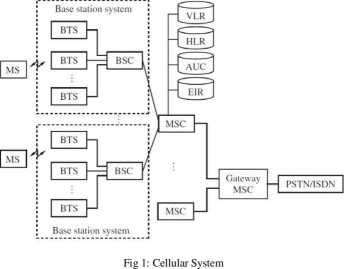6781097233
International Journal of Computer Science & Engineenng Survey (UCSES) Vol.6, No.2, April 2015
eavesdropping. The UMTS or 3G promised advanced services such as mobile internet, multimedia messaging, video conferencing etc. UMTS standards were defined by an international consortium called 3GPP (Third generation partnership project) [3].
1.1.2 Fundamentals of a cellular system
The generic błock diagram of a cellular system is shown in the Fig 1 below.

The basie geographical unit of a cellular system is called a celi is the geographical area covered by a transmitter. At the lowest level, a celi phone is connected to a base station (or base transceiver station) by a radio link. Multiple base stations are connected to and controlled by a base station controller. The connection between a base station and its controllers could be a microwave link, optical link in generał any radio link. Multiple base station controllers and upstream are connected to Mobile switching centre. The Mobile Switching Centre (MSC) forwards an incoming cali to the destination MSC. The MSC also keeps track of accounting and billing information. MSC are connected each other through wired networks such as Public Switched Telephone NetWork (PSTN).
The user has a subscription to some networks called as his home network. A one to one association between MSC and a network is maintained. An MSC has a database, called the Home Location Register (HLR) having information of all its subscribers. The data base contains the information of subscriber’s mobile number, the services availed and a secret key stored in the mobile known only to the HLR. HLR also maintains the dynamie information of its roaming customers for charging. It includes the current location of a user and the cellular network used by the user [4].
A subscriber may avail the services of other networks (called as foreign networks) that have an agreement for roaming with subscriber’s home network. Each cellular network also maintains a database called as Visitor Location register (VLR) of users currently visiting that network with the list of services the subscriber entitled to.2G technology introduced Subscriber Identity Module (SIM) card which Stores three secrets used for cryptographic operations [5]. The secrets are:
30
Wyszukiwarka
Podobne podstrony:
International Journal of Computer Science & Engineenng Survey (UCSES) Vol.6, No.2, April 2015 Th
International Journal of Computer Science & Engineenng Survey (UCSES) Vol.6, No.2, April 2015 co
International Journal of Computer Science & Engineenng Survey (UCSES) Vol.6, No.2, April 2015 Th
International Journal of Computer Science & Engineenng Survey (UCSES) Vol.6, No.2, April 2015 1.
International Journal of Computer Science & Engineenng Survey (UCSES) Vol.6, No.2, April 2015 Fo
International Journal of Computer Science & Engineenng Survey (UCSES) Vol.6, No.2, April 2015?
International Journal of Computer Science & Engineenng Survey (UCSES) Vol.6, No.2, Apnl 2015Secu
International Journal of Computer Science & Engmeenng Survey (UCSES) Vol.6, No.2, April 2015 sev
International Journal of Computer Science & Engmeenng Survey (UCSES) Vol.6, No.2, April 2015 Fig
International Journal of Computer Science & Engmeenng Survey (UCSES) Vol.6, No.2, April 20157.
International Journal of Computer Science & Engmeenng Survey (UCSES) Vol.6, No.2, April 2015 2.2
International Journal of Computer Science & Engmeenng Survey (IJCSES) Vol.6, No.2, April 2015 4.
International Journal of Computer Science & Engmeenng Survey (IJCSES) Vol.6, No.2, April 2015 4.
International Journal of Computer Science & Engmeenng Survey (IJCSES) Vol.6, No.2, April 2015 2.
International Journal of Computer Science & Engmeenng Survey (IJCSES) Vol.6, No.2, April 2015 GS
IJCSI International Journal of Computer Science Issues, Vol. 7, Issue 3, No 9, May 2010
12 IJCSI International Journal of Computer Science Issues, Vol. 7, Issue 3, No 9, May 2010 www.IJCSI
IJCSI International Journal of Computer Science Issues, Vol. 7, Issue 3, No 9, May 2010
14 IJCSI International Journal of Computer Science Issues, Vol. 7, Issue 3, No 9, May 2010 www.IJCSI
więcej podobnych podstron